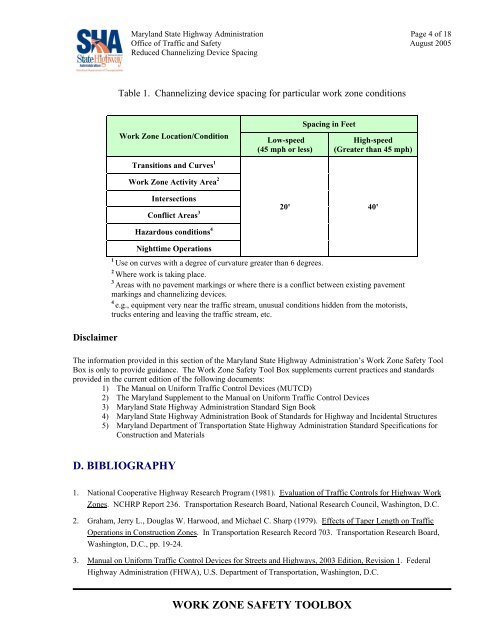Reduced Channelization Device Spacing - Maryland State Highway ...
Reduced Channelization Device Spacing - Maryland State Highway ...
Reduced Channelization Device Spacing - Maryland State Highway ...
You also want an ePaper? Increase the reach of your titles
YUMPU automatically turns print PDFs into web optimized ePapers that Google loves.
<strong>Maryland</strong> <strong>State</strong> <strong>Highway</strong> Administration Page 4 of 18<br />
Office of Traffic and Safety August 2005<br />
<strong>Reduced</strong> Channelizing <strong>Device</strong> <strong>Spacing</strong><br />
Table 1. Channelizing device spacing for particular work zone conditions<br />
Work Zone Location/Condition<br />
Low-speed<br />
(45 mph or less)<br />
<strong>Spacing</strong> in Feet<br />
High-speed<br />
(Greater than 45 mph)<br />
Transitions and Curves 1<br />
Work Zone Activity Area 2<br />
Intersections<br />
Conflict Areas 3<br />
20' 40'<br />
Disclaimer<br />
Hazardous conditions 4<br />
Nighttime Operations<br />
1<br />
Use on curves with a degree of curvature greater than 6 degrees.<br />
2<br />
Where work is taking place.<br />
3<br />
Areas with no pavement markings or where there is a conflict between existing pavement<br />
markings and channelizing devices.<br />
4<br />
e.g., equipment very near the traffic stream, unusual conditions hidden from the motorists,<br />
trucks entering and leaving the traffic stream, etc.<br />
The information provided in this section of the <strong>Maryland</strong> <strong>State</strong> <strong>Highway</strong> Administration’s Work Zone Safety Tool<br />
Box is only to provide guidance. The Work Zone Safety Tool Box supplements current practices and standards<br />
provided in the current edition of the following documents:<br />
1) The Manual on Uniform Traffic Control <strong>Device</strong>s (MUTCD)<br />
2) The <strong>Maryland</strong> Supplement to the Manual on Uniform Traffic Control <strong>Device</strong>s<br />
3) <strong>Maryland</strong> <strong>State</strong> <strong>Highway</strong> Administration Standard Sign Book<br />
4) <strong>Maryland</strong> <strong>State</strong> <strong>Highway</strong> Administration Book of Standards for <strong>Highway</strong> and Incidental Structures<br />
5) <strong>Maryland</strong> Department of Transportation <strong>State</strong> <strong>Highway</strong> Administration Standard Specifications for<br />
Construction and Materials<br />
D. BIBLIOGRAPHY<br />
1. National Cooperative <strong>Highway</strong> Research Program (1981). Evaluation of Traffic Controls for <strong>Highway</strong> Work<br />
Zones. NCHRP Report 236. Transportation Research Board, National Research Council, Washington, D.C.<br />
2. Graham, Jerry L., Douglas W. Harwood, and Michael C. Sharp (1979). Effects of Taper Length on Traffic<br />
Operations in Construction Zones. In Transportation Research Record 703. Transportation Research Board,<br />
Washington, D.C., pp. 19-24.<br />
3. Manual on Uniform Traffic Control <strong>Device</strong>s for Streets and <strong>Highway</strong>s, 2003 Edition, Revision 1. Federal<br />
<strong>Highway</strong> Administration (FHWA), U.S. Department of Transportation, Washington, D.C.<br />
WORK ZONE SAFETY TOOLBOX
















